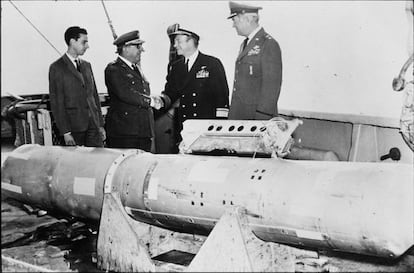Washington and Madrid to seal deal over 1966 Palomares nuclear accident
US agrees to remove around 50,000 cubic meters of contaminated soil from site

Washington and Madrid are finalizing a deal by which the United States is agreeing to take away around 50,000 cubic meters of soil that was contaminated when four hydrogen bombs accidentally fell off the Spanish coast near Palomares in 1966, in one of the Cold War’s worst nuclear incidents.
The soil will be shipped to the United States, where it will probably be stored in Nevada, according to officials familiar with the situation. US Secretary John Kerry is expected to sign the deal when he visits Madrid on October 19.
US officials have finally agreed to take the contaminated soil back to Nevada
The US Energy Department and the Spanish Foreign Ministry have both declined to comment on the matter.
The agreement comes just months before the 50th anniversary of the nuclear accident over the fishing village of Palomares (Almeria). On January 15, 1966 a B-52 collided with a tanker during mid-air refueling, causing the former to drop its four hydrogen bombs. One was found in the Mediterranean Sea, the other three on land. Two of them released radioactive material over two square kilometers of land.
For decades, the US had refused to take away the contaminated soil for fear of setting a precedent for claims by other countries.
While there is no definite decision regarding this latest cleanup initiative, the soil will likely be taken to the National Security Site in Nevada, which is located approximately 100 kilometers northeast of Las Vegas.
According to officials, Washington and Madrid have worked hard to turn this agreement into a political statement of joint cooperation to be issued during Kerry’s first visit to Spain. Last summer, the US secretary had to cancel a planned trip after suffering an injury in a biking accident in France.
After the agreement is signed, experts on both sides will continue to negotiate the technical aspects of soil removal and the conditions for its storage.
The costs will probably be shared by both countries and the transfer completed by the end of 2017.
The most striking aspect about this new agreement – according to sources with knowledge of the situation – is that the United States has agreed to take all the soil that cannot be decontaminated on site, as Spain doesn’t have sufficient safe storage area for the material.
For its part, Madrid will renounce claims to any future damages caused by the accident.
In January, the US Energy Department had begun to study the possibility of transferring the soil to Nevada but said the plan was still under consideration.
Madrid will renounce claims to any future damages caused by the accident
Except for routine blood analyses taken from nearby residents, officials had not made any clear moves to answer questions about the contaminated surroundings.
At the end of the 1990s, the Center for Energy, Environmental and Technology Research (Ciemat) reported high levels of americium (a plutonium compound) in the area.
In 2003, then-Prime Minister José María Aznar of the Popular Party decided to expropriate the land to prevent housing construction or agricultural uses.
After a further study, Ciemat concluded that around 50,000m3 of soil was contaminated with a half-kilo of plutonium. But Ciemat came up with the possibility of reducing the volume by compacting the soil into a 6,000m3 area.
English version by Martin Delfín.
Tu suscripción se está usando en otro dispositivo
¿Quieres añadir otro usuario a tu suscripción?
Si continúas leyendo en este dispositivo, no se podrá leer en el otro.
FlechaTu suscripción se está usando en otro dispositivo y solo puedes acceder a EL PAÍS desde un dispositivo a la vez.
Si quieres compartir tu cuenta, cambia tu suscripción a la modalidad Premium, así podrás añadir otro usuario. Cada uno accederá con su propia cuenta de email, lo que os permitirá personalizar vuestra experiencia en EL PAÍS.
¿Tienes una suscripción de empresa? Accede aquí para contratar más cuentas.
En el caso de no saber quién está usando tu cuenta, te recomendamos cambiar tu contraseña aquí.
Si decides continuar compartiendo tu cuenta, este mensaje se mostrará en tu dispositivo y en el de la otra persona que está usando tu cuenta de forma indefinida, afectando a tu experiencia de lectura. Puedes consultar aquí los términos y condiciones de la suscripción digital.
Últimas noticias
Most viewed
- Pablo Escobar’s hippos: A serious environmental problem, 40 years on
- Reinhard Genzel, Nobel laureate in physics: ‘One-minute videos will never give you the truth’
- Why we lost the habit of sleeping in two segments and how that changed our sense of time
- Charles Dubouloz, mountaineering star, retires at 36 with a farewell tour inspired by Walter Bonatti
- The Florida Keys tourist paradise is besieged by immigration agents: ‘We’ve never seen anything like this’








































